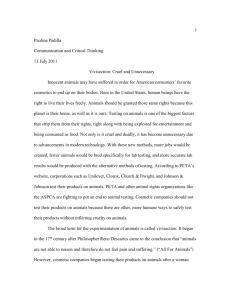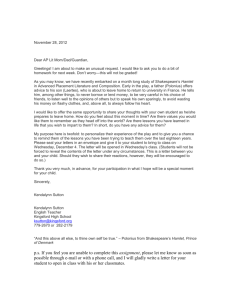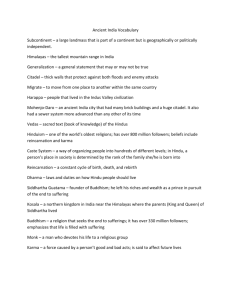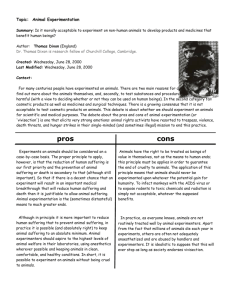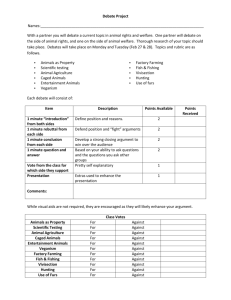Monism and suffering - Queen`s University Belfast
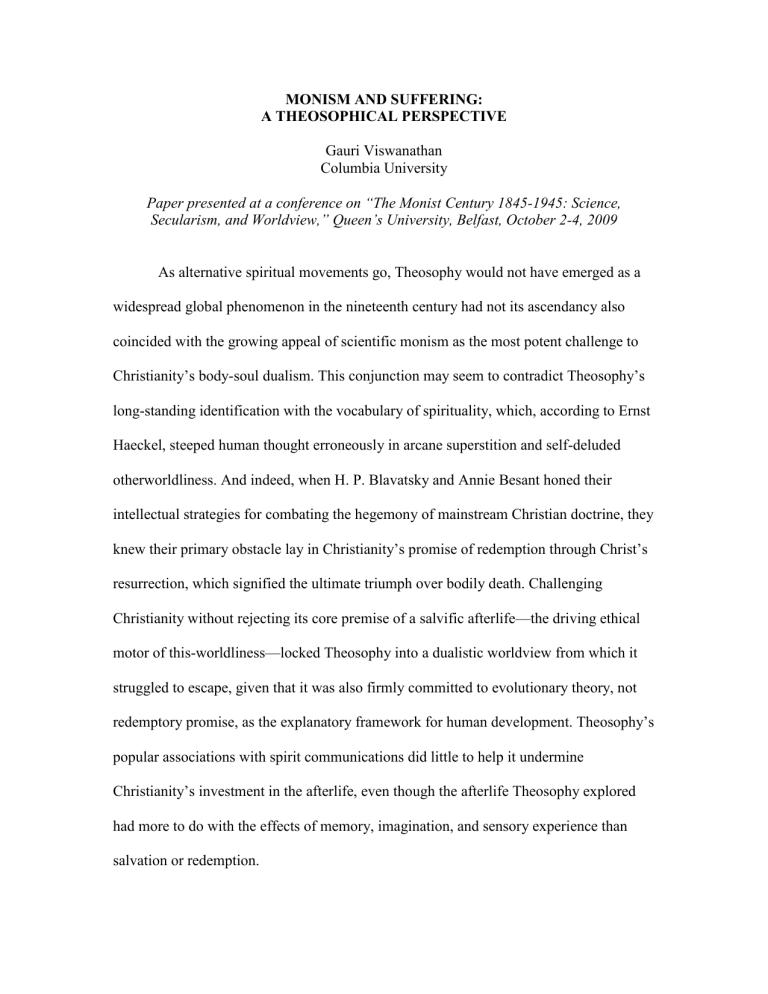
MONISM AND SUFFERING:
A THEOSOPHICAL PERSPECTIVE
Columbia University
Paper presented at a conference on “The Monist Century 1845-1945: Science,
Secularism, and Worldview,” Queen’s University, Belfast, October 2-4, 2009
Gauri Viswanathan
As alternative spiritual movements go, Theosophy would not have emerged as a widespread global phenomenon in the nineteenth century had not its ascendancy also coincided with the growing appeal of scientific monism as the most potent challenge to
Christianity’s body-soul dualism. This conjunction may seem to contradict Theosophy’s long-standing identification with the vocabulary of spirituality, which, according to Ernst
Haeckel, steeped human thought erroneously in arcane superstition and self-deluded otherworldliness. And indeed, when H. P. Blavatsky and Annie Besant honed their intellectual strategies for combating the hegemony of mainstream Christian doctrine, they knew their primary obstacle lay in Christianity’s promise of redemption through Christ’s resurrection, which signified the ultimate triumph over bodily death. Challenging
Christianity without rejecting its core premise of a salvific afterlife—the driving ethical motor of this-worldliness—locked Theosophy into a dualistic worldview from which it struggled to escape, given that it was also firmly committed to evolutionary theory, not redemptory promise, as the explanatory framework for human development. Theosophy’s popular associations with spirit communications did little to help it undermine
Christianity’s investment in the afterlife, even though the afterlife Theosophy explored had more to do with the effects of memory, imagination, and sensory experience than salvation or redemption.
2
Nor was Blavatsky’s identification of spirit with matter particularly convincing, and it even bore a touch of desperation, as she fended off her critics (including the atheist and avowed secularist Charles Bradlaugh) by insisting that Theosophy’s repudiation of a personal God rendered it incommensurate with theological aims:
And why cannot a Monist be a Theosophist? And why must Theosophy at least involve dualism ? Theosophy teaches a far stricter and more farreaching Monism than does Secularism. The Monism of the latter may be described as materialistic and summed up in the words, "Blind Force and
Blind Matter ultimating in Thought." But this—begging Mr. Bradlaugh's pardon—is bastard Monism. The Monism of Theosophy is truly philosophical. We conceive of the universe as one in essence and origin.
And though we speak of Spirit and Matter as its two poles, yet we state emphatically that they can only be considered as distinct from the standpoint of human, mayavic ( i.e
., illusionary) consciousness.
We therefore conceive of spirit and matter as one in essence and not as separate and distinct antitheses.
1
Blavatsky insisted on making a distinction between the monism of spiritual philosophy and that of materialistic science, for it allowed her to claim the validity of a monistic conception of life and nature while locating it in an ontological reality removed from the contingencies of historical and evolutionary development. The effect of her reference to
“the standpoint of human. . . . consciousness” is to keep alive the dualism inevitably created by subjective thought and the perspectivalism it engendered. In work after work,
1 H.P. Blavatsky, “A Force of Prejudice,” Collected Writings 1889 , vol. 11 (Madras: Theosophical
Publishing House, 1958), p. 336.
3 she repeatedly returned to “manifested being” as preserving “the dual contrasted poles or bases of all phenomena—subjective and objective .” 2 To Blavatsky, the monism espoused by science is annihilating and self-canceling, and it leaves no room for an “Absolute
Reality” separate from historical contingency. For this reason she insisted on bringing back the context of worldliness in which we live, in which duality of spirit and matter is the only way of conceptualizing form and substance. This-worldliness is one reason why she cannot completely subscribe to scientific monism, because it leaves no room for either history or spirituality. Wars, world tumult, and historical ferment all point to the demands of evolutionary necessity, which is basically incompatible with ontological reality. This tension is best described by the phrase “the age of progressive messianism.”
Blavatsky evades the charge of inconsistency by insisting on monism as an accurate description of Absolute Reality, but in the historical world there is duality which drives the course of events and produces the conflicts that stage the appearance of evolutionary necessity.
Yet, for all her rambling defense of Theosophy’s monism, Blavatsky’s most powerful argument against both the Christian and the atheistic worldviews drew upon a quote from her protégée Annie Besant that “this form of Pantheism [Theosophy] appears to me to promise solution of some problems, especially problems in psychology, which
Atheism leaves untouched.”
3
Like Besant, Blavatsky saw Theosophy as a more subtle resolution of issues involving agency and causation, which Christianity reduced to a manichaean dualism of good and evil, and atheism to random, mechanical instrumentality. As Blavatsky’s long quotation above suggests, Theosophy’s search for a
2 H.P. Blavatsky, “Psychology – “The Science of the Soul,” Lucifer , October 1896.
3 Annie Besant, An Autobiography (1893; Madras: Theosophical Publishing House, 1939), p. 321.
Also quoted in Blavatsky, “A Force of Prejudice,” p. 334.
4 meaningful yet worldly conception of human purpose problematizes both the binary worldview of Christianity—with its personified figures of God and the devil—and a mechanistic, motiveless idea of nature and history. Theosophy’s pursuit coincided with that of an age dissatisfied with the extremes of theological and materialistic thought. The definition of “mind as matter and matter as mind” not only offers no solution of the great psychological problem discussed but also ineffectively reduces one to the other in an impossible circularity.
4
However, Blavatsky’s polemical disposition never quite allowed her to explore in any depth those “problems in psychology” that attracted the attention of her younger disciple Annie Besant from the time she became acquainted with the Darwinist scientist
Edward Aveling and later the German materialist thinker Friedrich Büchner. In their own separate ways Aveling’s and Büchner’s theories offered Besant what she was seeking as she grappled with her crisis of belief in Christianity: a scientific and evolutionary explanation for suffering and pain. Unable to accept Christianity’s rationalization of suffering as redemptory, Besant discovered she had to look no further than the plight of workers, reduced to poverty by capitalist profit-making, to realize that suffering had the potential to play a revolutionary role in generating social confrontation, if not immediate social change.
5
Significantly, as Besant’s wide reading in socialist literature taught her, the body of the suffering worker could be effortlessly interchanged with two other figures of exploitation—that of the brutalized female and the maltreated animal. The depth of their
4 H. P. Blavatsky, “Absolute Monism,” Collected Writings 1888, vol. 9 (Madras: Theosophical
Publishing House, 1958), p. 15.
5 Anne Taylor, Annie Besant: A Biography (Oxford and New York: Oxford University Press,
1992), p. 178.
5 suffering could not simply be rendered in physiological terms but demanded an a priori imaginative capacity to apprehend the subjective experience of pain. Theosophy was conceived, in part, as a philosophical system expounding the motors of sensate life, as humans and animals coped with the conditions that both promoted and thwarted their development. The emphasis on biological survival and adaptation qualified Theosophy’s self-presentation as alternative spirituality and built political rationales into its philosophical premises. That is to say, Theosophy marked itself off from other monistic forms of thought by positioning itself as the culmination of evolutionary necessity, even as it also offered practical idealism as a way of thinking through the deepest philosophical questions of suffering. The cross-hatching of philosophical and political aims in Theosophy and other spiritual movements in the nineteenth century reflected the concerns of the growing body of female adherents, who turned to these movements to map female suffering in a continuum that also included animal suffering, with both females and animals struggling to survive in a world controlled by male scientific interests. Theosophy’s opposition to the body’s objectification in experimental science, even as it borrowed Darwinian science’s theory of evolutionary struggle and survival, served the interests of female reformers seeking to bring women’s subjectivity within a wider movement for justice and rights. If the movement for women’s rights received a strong impetus from the connections between female and animal suffering, Theosophy played no small role in this development. As Todd Weir notes, “debates over the meanings of categories became central sites for the articulation of ideological differences in the modern public sphere.” 6 To all intents and purposes, suffering brought females and animals under the same operative category.
6 Todd Weir, “The Secular Beyond: Free Religious Dissent and Debates over the Afterlife in
6
Curiously, many of these radical social movements did not begin out of a feminist impulse, nor were the causes to which women were drawn necessarily feminist ones. On the contrary, feminism was an outgrowth, perhaps even an unintended consequence, of the ferment against religious authoritarianism. To quote Weir again, “Science popularization, monism, and anticlericalism were integral parts of the republican and socialist milieus, as well as the life reform, pacifist, and radical women’s movements.” 7
The questions that interest me include the following: Why was the movement against animal cruelty so heavily dominated by women? What connections exist between antivivisection and the many conflicting causes that comprise the late nineteenth-century women’s movement? How do these connections redefine the debates on mind-body dualism? And finally, what role do alternative religions like Theosophy play in these debates, which deployed the language of secularism while opposing the secularist commitment to a nontranscendent order?
One approach to these questions is to examine how the protection of animal rights introduced new dichotomies into which women’s struggles could be inserted. Scientific and medical advances highlighted these dichotomies for women far more sharply than any other comparable developments. The masculine control of women was camouflaged by the apparent benefits conferred by scientific knowledge on women’s health and hygiene. The discourse of progress that cited the improved mortality rates of women blocked criticism of either science or the men who practiced it. But the vivisection of animals for experimental purposes belied the supposedly noble intentions of science and exposed the raw suffering that was inflicted in the name of knowledge: improvement at a
Nineteenth-Century Germany,” Church History 77:3 (September 2008), p. 630.
7 Weir, “The Secular Beyond,” p. 658.
price, in other words. Blavatsky anticipated an argument made many times in later years, notably by Peter Singer in our own time, that suffering, rather than the possession of speech or reason, determines who has moral rights: “A man of science, the most determined materialist, one who proceeds to vivisect a living animal with the utmost coolness, would yet shudder at the thought of laming—not to speak of torturing to death—his fellowman. . . . [A]mong those great materialists who were religiously inclined men [are there] any who have shown themselves consistent and logical in defining the true moral status of the animal on this earth and the rights of man over it.
8
Modern science, which made animals expendable in the search for cures for modern diseases, created new hierarchies of ontology that subordinated animal suffering to worldly ends. The ontological divisions between the materialism of science and the sanctity of biological life (human and animal) created a new ethical awareness about the nature of pain. Vivisection came to be seen as a weapon by which the new materialist medical sciences were removing “both vitalist concepts from physiology, and the links between physical health and moral order that were the foundation of sanitarian beliefs,” thus perpetuating materialism’s rejection of the mind’s influence over body.
9
But for all its moral claims, mainstream religion had little to offer by way of developing this awareness into action. Ideas of suffering as Christian atonement were too severely undermined by science to be effective in a battle that depended for its success on recognition of the visceral quality of pain. In complete opposition to a religious philosophy that saw pain as a necessary prelude to eternal salvation, the scientific
7
8 H.P. Blavatsky, “Have Animals Souls?” Collected Writings 1886-87 , vol. 7 (Madras:
Theosophical Publishing House, 1958), p. 25.
9 Mary Ann Elston, “Women and Anti-vivisection in Victorian England, 1870-1900,” in Nicholaas
Rupke (ed), Vivisection in Historical Perspective (London: Croom Helm, 1987), p. 275.
8 temperament viewed animal suffering as an instrument for improving the worldly condition of mankind. Because the terms of the debate had changed so dramatically, with the focus of progress shifting from spiritual redemption to temporal well-being, those who sought a spiritual basis to oppose animal vivisection ran up against a wall when they turned to Christianity. For there they found a religion already weakened by its inability to offer a viable, present-oriented, and activist ethics to deal with the physical dimensions of pain. The intellectual biographies of some of the nineteenth century’s greatest female reformers reveal their confrontation with this fundamental limitation of the religion in which they were born, as well as their search for ways of making social activism responsive to the physical reality of pain. Their path invariably took them in the direction of restating the age-old philosophical distinctions between dualistic and monistic conceptions of body and soul.
Even as antivivisection became a critical rallying point in the struggle against modern science, the inadequacies of mainstream religious institutions prompted a search for alternative religions. It was clear antivivisection could not be defended from a purely abstract antiscientism, since such a position represented antivivisection as being opposed to progress of any kind and lacking a substantive ethics or philosophy from which the case against science could be argued. The movement against animal vivisection found support in the reaction against science and a materialistic philosophy, which drove people to alternative religions like Theosophy. The appeal of such alternative worldviews was that science could be fought by paradoxically invoking scientific principles. There is no better example than the life story of antivivisectionist, feminist, and Theosophist Anna
Kingsford, who specifically sought a medical education in order to fight science from the
9 inside. Her life story illustrates how alternative religious systems, especially those that claimed they were closer to science than religion, emerged as powerful tools in the fight against animal vivisection. Thus, antivivisection, through alternative religions disdaining the dualism of Christianity, became a vital rallying point in the struggle against modern science and a node for an emergent feminism.
* * * * * * * * * * * * * * * * * * * * * *
Frances Power Cobbe (1822-1904) superimposed a feminist agenda on the movement for animal rights that had emerged in the late eighteenth century. Although there was no overt connection between animal rights and women’s emancipation, it was from the standpoint of antivivisection that she could make her most effective case for women’s rights, since it offered her the language to attack any scientific advance that challenged religion or maltreated animals. Before proceeding, we should be clear about
Cobbe’s “radicalism”: Though activist in her espousal of animal causes, her political leanings were conservative, reflecting her own background as a member of the landed aristocracy. Cobbe was born to Evangelical Christian parents who also came of old courtier families. This background is essential to understanding her later hostility to science and the feminism that was an outgrowth of her antiscientific, antimaterialistic position. Despite her later rebellion against orthodox Christianity and the religious culture of her parents, Cobbe retained an abiding commitment to the values of the landed aristocracy. Her hostility to the rising middle classes grew in proportion to her view that they were the crass byproducts of modern capitalist expansion. As a member of the
Anglo-Irish landed gentry, Cobbe derided the influence that the middle classes were
10 exercising in cultural life since the passage of the reform bills, of which the material power of scientists in Victorian England was a symptom. Notwithstanding her heterodoxies and theological disputes with her parents, science came to epitomize everything that challenged the stability of a society based on the landed English aristocracy. She believed that the political ascendancy of the English middle-class directly contributed to the rise of a new scientific regime that threatened the integrity of the old order. Convinced that the dismantling of the old order was being hastened by scientific experimentations, she made antivivisection the site for waging war against science.
Cobbe’s distaste for scientific materialism was linked to her loathing of the middle classes. In much the same way that she derided the low-level culture of the middle-classes as a mindset driven by a relativist view of morality and principle, she anathematized science as bourgeois, its advancement of knowledge won at the cost of a rapaciousness that affected animals and women alike. What Foucault described as the
“boldness of the gesture that violated only to reveal. . . [K]nowledge spins where once larva was formed” was, for antivivisectionists, all violation and no knowledge.
10
The flawed morality of English doctors, Cobbe alleged, could be traced to their middle-class social origins: driven primarily by a money-oriented culture, they had learned to rationalize suffering—here, animal suffering—as merely a necessary means to achieving monetary success.
10
Foucault is careful to point out, however, that the Enlightenment needed this myth to justify its excursions, in order to show the transformation of bodies from putrified waste to sources of new knowledge. See Michel Foucault, The Birth of the Clinic: An Archaeology of Medical Perception (New
York: Pantheon Books, 1973; Vintage Books, 1994), p. 125.
11
Cobbe’s stance on antivivisection is important in an account of the genealogies of feminism and suffering because it prepared the ground for her subsequent appeal to women’s rights. Vivisection belonged in the same frame of reference as the institutionalized enfeeblement of women, and it was a framework, as Cobbe pointed out, that was entirely dominated by science. The people who tortured animals were also making invalids of women.
11
As Harriet Ritvo has shown, animals were identified with women’s dangerous sexuality, to be controlled and contained.
12 Victorians’ relation to dogs exemplified a number of tensions in Victorian class and sexual ideologies.
Portraying scientists as inebriated husbands and doctors as purveyors of female invalidism, Cobbe was vividly able to draw attention to women as guinea pigs trapped by the world of science.
Masquerading as the pursuit of scientific truth, the mutilation of animals was in fact motivated by the same sexual predatoriness and unrestrained male sexuality that subordinated women. Antivivisection had strong affinities with the campaigns against compulsory smallpox vaccination and the Contagious Diseases Acts, along with the latter’s campaign for sexual purity. The fear of bodily violation spurred antivivsectionists to oppose the new scientific momentum. A vast literature on antivaccination consistently reflected popular fears about the pollution of human blood or the animalization of human beings by the inoculation of animal fluids.
13
The fear of having their bodies corrupted or violated spurred some groups to oppose health programs.
11 Frances Power Cobbe, “The Rights of Man and the Claims of Brutes,” in Andrea Broomfield and Sally Mitchell (eds), Prose by Victorian Women (New York and London: Garland, 1996). See also
Frances Power Cobbe, Life of Frances Power Cobbe, by Herself , 2 vols. (Cambridge: Riverside Press,
1894).
12 Harriet Ritvo, The Animal Estate (Cambridge: Harvard University Press, 1987).
13 Richard French, Antivivisection and Medical Science in Victorian Society (Princeton: Princeton
University Press, 1975), p. 388.
12
The organized opposition to compulsory vaccination began in 1871, as the mandatory appointment of vaccination officers in all localities heralded the implementation of the previously unenforced 1853 Vaccination Act. The Contagious Diseases Acts, passed in
1864, 1866, and 1869, established state regulation of prostitution in garrison towns.
Action against prostitutes began in 1869 and continued until their suspension in 1883 and repeal in 1886. All three movements saw the involvement of many of the same people.
Richard French notes that the agitation against these legislations appealed to “the same kinds of fears of, and hostilities toward, science and medicine.”
14
All three were campaigns against the increasing claims of science and medicine to the right to dictate morality and personal behavior. Attacks were made on doctors’ claims to authority and on what had fast become the basis of medical education, i.e., materialist science.
To Cobbe, the eclipse of conservative power by the time of the third reform bill of
1884 revealed the inadequacy of mainstream Christianity, as a viable religious philosophy, to oppose the new trends. Turning her back on Christianity, she turned to new religious beliefs in an effort to respond more effectively to the growing hegemony of science. She embraced Theism as a more attractive alternative because she believed it would empower her to place morality and goodness at the center of all things, displacing the moral relativism that had become the ideology of the middle classes. Moreover,
Theism gave her an absolute belief in the moral autonomy of women and in women’s mental and moral difference from men, both of which beliefs gave the defining strokes of her feminism. In her “Essay on the Theory of Intuitive Morals” (1855) Cobbe joined
Kant’s morality with the will to do right, laying the basis for a new brand of ethical
14
French, p. 229.
13 activism whose goal was the attainment not only of a just but also a humane society. The inclusion of compassion and empathy for suffering animals in Cobbe’s conception of justice must be credited to her conversion to Theism, which provided her with the necessary philosophical universalism to stake claims to women’s rights on principles beyond gender equity alone. While Cobbe never wavered in her denunciation of male victimization of women in the name of science, she made antivivisection the cornerstone of her Theism. If Theism were to be fully vindicated as a more comprehensive philosophy than Christianity, the test of a compassionate and just society must be seen to lie in its treatment of animals.
However, though Theism gave Cobbe an antimaterialistic philosophy, by itself it was too abstract to contest science. Antivivisection, on the other hand, represented a social movement she could draw upon to infuse spirit into a materialistic, scientific world. In its practical effects antivivisection complemented Theism. Indeed, at times it seemed to be an extension of Theism, as antivivisectionists valued animals for their mental, moral, and spiritual qualities. From a graphic description of scientists’ mutilation of animals in the name of rational progress, Cobbe was able more securely to place the spotlight on women as well, whose subject position was interchangeable with that of animals. The rights of women were urged on principles of a universal humaneness that included animals just as much as it did humans. By emphasizing the psychic and spiritual continuities between animals and humans, antivivisectionists also found a way of responding to Darwinism, which, it could be said, also insisted on the links to animals:
14 by turning the connections around spirit rather physiology, antivivisectionists undermined the scientific terms that rationalized experimental science.
15
The most effective response to the hegemony of science—and, by extension, of the middle class—was to promote the old-fashioned values of love and goodness. The cause of animal vivisection permitted this assertion with even greater force. Moreover, the best proponents of a philosophy based on love and goodness were undoubtedly women, and Cobbe, cofounder of the Victoria Street Society for the Protection of
Animals liable to Vivisection (VSS) in 1875, made this argument the cornerstone of her argument linking feminism and animal rights. When, in later years, it appeared the VSS agenda had become limited to the restriction rather than abolition of vivisection, she withdrew and founded the British Union for the Abolition of Vivisection (BUAV).
Cobbe was among the first to articulate a coherent role for women in the movement against vivisection. Her contribution is all the more remarkable in a climate where, although women dominated the antivivisection movement,
16
it was not necessarily the case that antivivisectionists were feminists, or had feminist leanings. Queen Victoria and
Angela Baroness Burdett Coutts, who both opposed the women’s movement, supported antivivisection with the same ardor as did such feminists like the pioneer doctor Elizabeth
Blackwell, the suffragette and Irish Republican Charlotte Despard, and Annie Besant, after her conversion to Theosophy. But despite the presence of these prominent figures, antivivisection was never exclusively a woman’s cause. Men who both supported and opposed women’s movement were on the side of antivivisection, just as, conversely, some feminist women, such as Elizabeth Garrett Anderson and Eleanor Sidgwick,
15 French, p. 384.
16 Richard French notes that antivivisection societies were 40 to 60 per cent female. See French, p.
239.
15 opposed the cause of antivivisection. Although there were no natural links between antivivisection and feminism, or no clear correspondence between the constituencies that attracted either movement, it was the case, as Richard French points out, that “levels of female participation in the antivivisection movement. . . were the very highest for movements without overtly feminist objectives.” 17
Any movement in which women sought to play an active and public part in the
1870s and 1880s was inescapably entangled with the “woman question.” Like spiritualism, antitivisection gave a fillip to women’s public role by highlighting, rather than denying or opposing, their femininity. The success of the movement in drawing large numbers of women indicated how effectively concepts of femininity and moral superiority worked towards enabling women to emerge in the public sphere and in areas not normally associated with traditional female roles. The important point is that the
Victorian ideology of femininity was not terribly undermined by women’s involvement with movements like antivivisection, which conferred new leadership roles on them, even if within traditional understandings of women’s nature. Indeed, the traditional representations of women as nurturing care-givers were yoked to activist meanings.
Antivivisection brought to the forefront discussion of the place and role of women in public life. In this sense, to claim an association between women’s activity in organized antivivisection and the women’s movement in late nineteenth-century feminism is a tautology. But this does not explain why women, in particular middle- and upper-class women, were so concerned about vivisection and animal welfare.
18
Moira
Ferguson perceptively suggests that the importance of antivivisection for feminism lies in
17 French, pp. 239-40.
18 Mary Ann Elston, “Women and Anti-vivisection in Victorian England, 1870-1900,” in
Vivisection in Historical Persepctive , edited by Nicolaas A. Rupke (London: Croom Helm), pp. 270-71.
16
Cobbe’s articulation of a new definition of gendered, ethnocentric Englishness.
19
Since compassion toward animals was synonymous with traditional English virtues and a feminist politic, the glory of science could not be considered synonymous with the glory of England. Cobbe contended that vivisection undermined Englishness and therefore must be regarded as an evil. She portrayed scientists as drunken husbands and doctors as purveyors of female invalidism: trapped by the world of science, women were as helpless as guinea pigs.
If antivivisection appealed to Cobbe as a cause from which to wage war against the new order, there were good historical reasons. Richard French points out that animals functioned in the English imagination as a “symbol of the potent myth of uncomplicated rural existence,” and animals’ links to land were the basis upon which British society was still structured.
20 Whatever the external social and cultural changes, the presence of animals was a reassuring reminder that England was a nation that accommodated a variety of life forms. “The cult of pets flourished in an urban society starved for points of reference to the life-style of the landlord.”
21
But Cobbe could not sound the rural theme alone. Despite her yearning for an older, land-based order, Cobbe needed an urban constituency to build a strong and effective antivivisection movement. Because, in the metropolis, pets were kept for emotional rather than utilitarian reasons, the suffering of animals had a special poignancy that further marked the difference between city and country. As a result, the power base of antivivisection was primarily urban.
19 Moira Ferguson, Animal Advocacy and Englishwomen, 1780-1900 (Ann Arbor: The University of Michigan Press, 1998), p. 105.
20 French, p. 373.
21 French, p. 373.
17
Cobbe exposed the contradictions in Darwinism: how could evolution coexist with the view that animals had no consciousness? If scientists truly believed in a chain of connections between man and animals, their practices belied their convictions: “Not merely our corporeal frames, but Thought, Memory, Love, Hate, Hope, Fear, and even some shadowy analogues of Conscience and Religion have been traced by the great thinker at the head of this school, throughout the lower realms of life upon this planet; and, in the eyes of most cultivated and thoughtful persons in these days, the claims of a dog, an elephant, a seal or a chimpanzee, to consideration and compassion, are at least as high as were those of a Negro, a century ago in the eyes of a Jamaica planter.” 22
If
Darwin was to be believed about the proximity of animals and humans, then the scientists who vivisected animals were like drunken husbands abusing those closest to themselves and, like wife-beaters, deriving pleasure from the pain they inflicted. Thus, Darwinisn paradoxically facilitated Cobbe’s argument about a linked consciousness between animals and humans, and it was a position from which she could then attack science with devastating force for having violated that connection.
Antivivisectionists were particularly disturbed that the Contagious Disease Acts severed the logical relation between sin and disease, which many Victorians implicitly believed was the bedrock of moral conduct. The Contagious Diseases Acts allowed men to go unpunished for the consequences of sin. Vivisection had become the weapon by which the new materialist medical science was eliminating both the vitalist concepts from physiology and the links between physical health and moral order that were the foundation of sanitarian beliefs. Pasteur’s discoveries were among the many that were attacked for reducing disease to a matter of chance encounters with germs. In targeting
22 Cobbe, “Fallacy of Restrictions”; quoted in Ferguson, p. 114.
18 disease, not sin, as the greater evil, society had lost its moral compass, with health rather than virtue being its primary goal. Staunch antivivisectionists like Frances Power Cobbe repeatedly warned of the dangers posed by materialism’s reification of the body over all other faculties. By isolating the body as the sole object of modern scientific knowledge, vivisection had unleashed a moral degradation whose consequences would be catastrophic. Contrary to Evelleen Richard’s contention that Cobbe’s Theism could not be sustained in a period of religious decline, nor effectively challenge a scientific establishment geared to the demands of a capitalist economy and the gendered public sphere, Cobbe’s belief in Theism strengthened in proportion to her revulsion from science as rampant materialism.
23
Yet, despite her repudiation of orthodox Christianity, Cobbe’s conversion to
Theism did not imply that she rejected the norms of being English, with which
Christianity was typically identified. On the contrary, as Moira Ferguson provocatively suggests, Cobbe’s conducted her campaign against vivisection in order to restore the true
English virtues of honor, compassion, and justice, which she believed had been thwarted by the new scientific spirit of the age. In other words, vivisection had to be considered un-English, because it diverted a society that valued science more than life from the true path of spiritual realization. Since the soul matters more than the body, scientists—whose profession by definition was body-based—possessed little spiritual orientation and emblematized a materialistic, morally backsliding age. Scientists contaminated
England’s reputation as a freedom-loving nation, since compassion for animals was synonymous and interchangeable with traditional English virtues. Cobbe held an
23 Evelleen Richards, “Redrawing the Boundaries: Darwinian Science and Victorian Women
Intellectuals,” in Victorian Science in Context , edited by Bernard Lightman (Chicago: University of
Chicago Press, 1997), p. 136.
19 interesting view on the failure of moral fiber in her contemporary England: “Notably it seems that the old Courage of Englishmen is dwindling away. Almost every month cases come to light wherein men—even soldiers fail to stand by their comrades in danger; or wherein a crowd of fifty people witness a child drowning in a shallow pond without an effort to save it.” 24
Cobbe justified imperial interventions as a means of recovering a vanishing past whose loss she bemoaned, while, at the same time, she privileged spiritual values and goals.
The flip side of Cobbe’s critique of vivisection as un-English was that the scientists who practiced it were likened to all those who fell outside the English pale, the
“savages” of Africa and the “wild tribes” of India. Cobbe drew a chain of connections between vivisection, brutal husbands, and savage Africans, equating materialistic tendencies and unrestrained male sexuality with potentially uncolonizable peoples: “The primary human feeling in the savage. . . is not sympathy with suffering, but . . .
Heteropathy; which inspires brutes and birds to kill their wounded or diseased companions.” 25
Animals are regarded as having souls and must be saved from extermination by “civilizing” (scientific) Englishmen. Indeed, the very notion of
“civilization” fell under bitterly ironic scrutiny in Cobbe’s hands. Vivisectionists in her view were uncolonized people, too distanced from respect for life. As a result, they fell short of a positive cultural identity and sullied England’s reputation.
In a peculiar rhetorical twist, Cobbe compared scientists to those who were untouched by the healing hand of English colonialism. Vivisectionists lay outside the mainstream of decent English behavior, forfeiting their location within the human
24 Cobbe, “Hygielotry,” The Peak in Darien (1882) pp. 86-87.
25 Cobbe, “Significance of the Vivisection Victoria Street Society, “ 1891.
20 community. Cobbe’s assault on vivisection reconceptualized Englishness by introducing a new imperial narrative about the protection of others.
26 The more established imperial narrative was male; it was based on the drive for knowledge and power. The other narrative Cobbe sought to bring into view was female. She found a new role for women as bearers of an antiscientific civilization, a real civilization based on spirituality, not clinical reason. She integrated caring about animals into a feminist politic that designated women as “invincible global civilizing agents.” Antivivisection appealed to the same women who engaged in the moral reform of intemperate men and uncivilized pagans, and thus entered the discourse of the civilizing mission.
27
Indeed, the argument that women were civilizing agents, as proven by the ethical merits of antivivisection, offered the grounds for extending women’s influence to the public sphere. Josephine Butler and
Frances Power Cobbe were careful to reassure their male readers that women’s involvement with such public movements as antivivisection was not at odds with woman’s guardianship of the domestic sphere, but the means by which this could be guaranteed.
* * * * * * * * * * * * * * *
26 Antivivisection had other nationalist dimensions. Richard French notes antivivisection’s interesting analogue to literary criticism. French naturalism came under heavy attack by some antivivisectionists, most notably William Lilley. Lilley denounced French naturalism for being symptomatic of a raw, clinical attitude to life that stripped away capacities for an emotional life. The hostility to naturalism (“disease in fiction”) converged with the English criticism of the French. Thereafter, antivivisection could tap into nationalist feeling. More research is needed to find out whether, apart from
Lilley, there were other English literary critics who were antivivisectionists, and to what extent antivivisection might have contributed to a distinctly English style of writing marked off from continental styles. If this were the case, then we could say with some confidence that antivivisection becomes the reference point for a new brand of Englishness.
27 Elston, “Women and Anti-vivisection in Victorian England, 1870-1900,” p. 271.
21
Theosophy contributed two important feminists who were also antivivisectionists,
Anna Kingsford and Annie Besant. Janet Oppenheim observes that both were “highspirited, intelligent women who found intolerable the limitations of married life in the third quarter of the nineteenth century and who. . . ultimately found satisfaction in the role of religious prophet.” 28
Besant may have been the more famous of the two, but
Kingsford (1846-88) was the leading antivivisectionist among the Theosophists. Yet it is interesting to note how comparable their religious backgrounds were, and how both their careers were determined by their rejection of Anglicanism. But while Besant followed a much more varied trajectory, moving from atheism to secularism and finally to
Theosophy, Kingsford took what appeared to be at the time a more conventional path, that is, conversion to Roman Catholicism. But even Roman Catholicism failed to satisfy her intense spiritual needs, and she undertook studies in the occult sciences, elaborating an individual (if somewhat idiosyncratic) theology consisting of a bricolage of
Christianity, Renaissance magic, and Eastern mysticism. Like Besant, she too converted to Theosophy, but conflicts over leadership of the movement with another major
Theosophist, A.P. Sinnett, caused her to break away from the London Theosophical
Society (of which she was president) and later to set up the Hermetic Society in 1884 with her long-time friend and collaborator, Edward Maitland. Already by this time,
Kingsford had become an avid supporter of animal rights. Her conversion to Theosophy and Hermeticism went in tandem with her growing activism as an antivivisectionist. Like
Cobbe, she believed there was no greater index of social injustice than cruelty toward animals. How a society treated animals revealed its plane of ethics: human rights, as we
28 Janet Oppenheim, The Other World: Spiritualism and Psychical Research in England, 1850-
1914 (Cambridge: Cambridge University Press, 1985), p. 185.
22 know it today, would be a meaningless concept if it did not also include animals in its field of intervention. Theosophy gave Kingsford a belief in the unity of living organisms.
She studied medicine not just for its own sake, but more importantly to fight vivisection from within the halls of science. Medicine became a stepping stone for Kingsford’s intense explorations of occult studies; indeed, unlike Cobbe who was deeply hostile to spiritualism and the occult, Kingsford came to see the acquisition of magical power through occult study as a weapon against the leading vivisectors of the time, especially
Louis Pasteur. Janet Oppenheimer suggests that Kingsford’s frailty and illnesses account in part for her almost desperate fascination with the occult, which became in her eyes a weapon of the weak to attack medical researchers who hid behind the seemingly invincible power of science. For instance, she proudly claimed credit for the death of a prominent vivisector in Paris, announcing that “the will can and does kill.” 29
An active suffrage campaigner, Kingsford made it her life mission to protect animals against vivisection with such religious zeal that many people believed she sought martyrdom on this issue. Accounts of her dreams about animals’ suffering in labs are suffused with theosophical imagery, especially of the soul trapped in the suffering body.
Kingsford remained active in the campaign against vivisection until her death in 1888.
Despite their differences on the role of the occult in modern spirituality, Cobbe and
Kingsford shared an abhorrence of the tyranny of materialist medicine. But even more important than their fight against experimental medicine was their common understanding that women’s causes were best served by linking up with other moral reform activities, such as antivivisection, even though superficially nonfeminist in its objects. “Such nonfeminist activism was functional for feminism because it permitted a
29 Oppenheim, p. 189.
23 deemphasis of the noisy demanding of rights. . . while publicly demonstrating female capabilities, and providing women with unprecedented opportunities for administrative and quasipolitical experience.” 30
Perhaps even more than Cobbe, Kingsford saw antivivisection as a crucial site of feminism, far stronger in many ways than explicit feminism. Edward Maitland wrote of her: “Though sympathising to the last in the movement for the enfranchisement of women, she did not long continue to take an active part in it. The reasons for her withdrawal were manifold. One was her conviction that women would more successfully achieve their desired emancipation by demonstrating their capacity for serious work than by merely clamouring for freedom and power. . . It was by magnifying their womanhood, and not by exchanging it for a factitious masculinity, that she would have her sex obtain its proper recognition.” 31
On this point
Cobbe and Kingsford found common accord, and indeed, as Evelleen Richards notes, feminism’s realpolitik for Cobbe lay not so much in women’s suffrage or higher education but its unequivocal stance on antivivisection.
32
Kingsford’s empathy for animal suffering grew in proportion to her disillusionment with overt feminism for its role in “hardening” women. Antivivisection conjoined neatly with feminism, in her view, and helped to restore the qualities of compassion and tolerance that organized feminism was slowly losing.
At the same time, Kingsford’s staunch feminist beliefs strengthened her fight against the vivisection of animals, since she based her argument solidly on the experience of suffering shared by women and brutes. But in fact the uncompromising vehemence—
30 French, p. 245.
31 Edward Maitland, Anna Kingsford: Her Life Letters Diary and Work , vol. 1 (London: George
Redway, 1896), p. 19.
32 Richards, “Redrawing the Boundaries,” p. 130.
24 some would say extremity—of her views is clearer when placed in the context of her theology, which she developed with her close friend and mentor Edward Maitland. The doctrine of reincarnation was critical to this theology, for the belief that the soul passes through a series of reincarnations, from plants through animals to man, led Kingsford to maintain that animals and humankind were united, not simply biologically, but far more substantially through their location in a field of life forces connecting all created beings.
This was in congruence with the theosophical view that living organisms are joined in a progressive chain of development. In Kingsford’s tortured nightly dreams, the animal vivisected in the scientist’s laboratory, whether rabbit or horse or dog, bore the face of a human child: “And so, when they bound down a horse and gathering round him, cut into him with knives, I saw the human shape within him writhe and moan as if it were a babe in its mother’s womb. . . . Do you not see that your victim is of your own kind, a child that is human?” 33
Theosophy appealed to women in particular because it offered them opportunities for leadership and public expression. Theosophy’s fusion of cosmic and worldly planes gave an impetus to women’s claims to equality with men, for Theosophy’s conception of the body as a temporary vehicle for an eternal spirit allowed for a blurring of biological and sexual differences. In other words, as the spirit passes through progressive stages reaching from material forms through mineral finally to the angelic, it reincarnates innumerable times in male and female guises. Theosophy’s belief in reincarnation, especially the view that reincarnation can take male or female forms, human or animal, appeared to offer the foundation for a spiritual politics of gender equality. If each soul contained within itself both male and female natures, then women’s claims to equality
33 Maitland, p. 338.
25 with men were justified on the grounds of complementarity, in that men and women were two halves of a single soul. Thus, Theosophy provided “a theoretical legitimation at the highest cosmological level for mundane notions of equality between the sexes.”
34
Mary
Elston further suggests that this understanding of Theosophy “was also compatible with a militant feminism that identified male nature with materialism, carnality and evil, and female with moral superiority and spiritual love.”
35
Just as antivivisection attracted feminists and nonfeminists alike, making it difficult to ascribe a causal relation between them, similarly Theosophy attracted women who both claimed and opposed feminist leanings. Yet there were affinities between them. Diana Burfield, writing on Theosophy and feminism, points out that many
Theosophists who showed scant interest in either women’s suffrage or the political aims of the women’s movement were nonetheless sympathetic to its social and educational objectives, “if only because they themselves exhibited the self-determination necessary to obtain higher education, pursue a professional or artistic career, or engage in writing and public speaking.” 36
Commitment to gender equality converged with Theosophical aims only to the extent that a universal brotherhood was Theosophy’s professed goal.
Although Kingsford was attracted to Theosophy because of its belief in reincarnation, astral bodies, the concept of karma, and the idea that God is the “substance of humanity,” she could not rest easy in its fold. One reason was that, unlike other
Theosophists, especially Blavatsky, who saw Theosophy as a radical break from
Christianity, Kingsford felt she was a Christian reformer who was attracted to Theosophy
34 Diana Burfield, “Theosophy and Feminism: Some Explorations in Nineteenth-Century
Biography,” in Women’s Religious Experience
, edited by Pat Holden (London and Canberra: Croom Helm,
1983), p. 36.
35 Elston,“Women and Anti-vivisection in Victorian England, 1870-1900,” p. 276.
36 Burfield, “Theosophy and Feminism,” p. 36.
26 less for its anti-Christian character than in order to rediscover the ancient esoteric wisdom that had been lost from institutional Christianity. Her restlessness with Theosophy’s more overtly pantheistic concerns caused her finally to break away and join the Hermetic
Society as a sort of “Speculative Church Reform Society.” From within the Hermetic
Society Kingsford made it her mission to show that Christian revelation, far from being the antagonist of esoteric knowledge, was in fact its heir. In tracing Christianity to its preinstitutional roots in Gnosticism, Sufism, Kabalism, and neo-Platonism, Kingsford reaffirmed Christianity’s affinities with the ancient wisdom of other esoteric sects, while progressively turning away from the New Testament as the symptomatic representative of modern Christianity. To her mind such affinities with other sects of ancient wisdom proved the universality of Christianity and its enduring efficacy in a time of world change and upheaval. Kingsford’s theology bore the firm imprint of her fervent feminist sympathies. She announced that “the object of all sacred mysteries, whether of our Bible or other,” was “to enable man anew so to develop the Soul, or Essential Woman, within him, as to become, through Her, a perfect reflection of the universal Soul, and made, therefore, in what, mystically, is called the image of God.” Her celebration of the feminine nature of the divine principle led to her exhortion to men to “exalt[ ] the Woman in themselves” if they were ever to attain “the full intuition of God.”
37
Yet, without her involvement in the antivivisection movement, Kingsford’s feminism would not have had an adequate structure of reference. If the endpoint of reincarnation was the dissolution of the material body, the pain that the body was subjected to in the earthly life was seen as male science’s brutal attempt to thwart the release of the suffering soul. Women’s identification with animals intensified in
37 Oppenheim, p. 188.
27 proportion. Women saw themselves as horses being flogged and beaten, and many saw their own condition grotesquely embodied in the figure of an animal bound to a table by straps, with the vivisector’s knife at work on its flesh. The sight evoked anger and despair in women. Antivivisectionists like Kingsford and Cobbe were able to move their largely female audience to unceasing wails and sobs by graphically drawing up a picture of animals pinned down by the precision instruments of modern science. To medical students, other hand, such graphic appeals were merely seen as a new kind of female demogoguery, confirming women as volatile, unstable, overemotional, and manipulative.
Darwin and Huxley dismissed antivivisectionists as “half-mad” fanatics, and attacked women’s identification with animals as just one more example of a hyperbolic imagination that produced false claims of victimization. “As antitivivisectionists
[women] were doubly subversive, treading on their femininity to unman the scientist on his own ground."
38
Attacked for being sentimental, women were able to use the emotional identification with suffering as a weapon of choice to seize the high ground, though this should not be construed to mean, as Evelleen Richards mistakenly suggests, that women also succeeded in securing power over male scientists and doctors. One measure of Theism’s political reach is that feminization of feeling only served to reinforce the masculinization of reason, and reproduced the very Darwinian definitions of feminine nature that rationalized women’s exclusion from science.
Through her training in medicine, Kingsford had a close view of the gynecological treatment of women and was appalled to conclude that surgery was no more than an extension of vivisection, with doctors using women in the place of dogs and cats. She was especially outraged to witness poor women as the worst victims of modern
38 Richards, “Redrawing the Boundaries,” p. 131.
28 medicine, noting that poor patients were operated on without anaesthesia: “Paupers are thus classed with animals as fitting subjects for painful experiment, and no regard is shown to the feelings of either.” 39
The working-class woman as a species of animal had become an especially effective trope in legitimizing doctors’ gynecological explorations with the same zest that animals were vivisected for medical purposes.
Kingsford’s increasingly shrill religious rhetoric served to expose the religious vocabulary of the vivisectionists she opposed. As Coral Lansbury points out, antivivisectionists challenged something that was far more powerful than a scientific theory: “They were combating a secular faith which was as appealing in its certainties as
Marxist doctrine.” 40
If doctors justified their experiments on animals (and women) by invoking absolute laws in nature (“the mechanisms of life can be unveiled and proved only by knowledge of the mechanisms of death”), it was the job of antivivisectionists like
Kingsford to strip away the mantle of a new priestly authority donned by doctors. What struck her as especially horrifying was the spectacle of doctors, under the guise of priestliness, usurping the moral and social issues that antivivisectionists had been trying to draw attention to as objects of their violation. “The medical profession was invested with the trappings of religion, and the surgeon, as high priest, conducted the ceremonies in the new temples of laboratory and operating theatre.” 41
* * * * * * * * * * * * * * * * * *
39 Coral Lansbury, The Old Brown Dog: Women, Workers, and Vivisection in Edwardian England
(University of Wisconsin Press, 1985), p. 87.
40 Lansbury, p. 164.
41 Lansbury, p. 168.
29
Few people will dispute the frustrations of charting Annie Besant’s career. Her sojourn through a number of different causes and movements—from freethought and atheism to socialism and finally to Theosophy—meant that she aligned herself at various times with issues that she was later to repudiate. Unlike Cobbe and Kingsford, Besant had far more ambivalence toward science, and that accounts for her vacillating position on animal vivisection: at times she was in favor of it and at other times opposed. Her feminism likewise fluctuated from one extreme to another. Besant’s conflicted attitudes to science took on an especially fraught character in the context of women’s attacks on materialist medicine, such as those of Kingsford which explicitly connected the antivivisection movement to spiritualism and Theosophy. Besant’s own mentor, H. P.
Blavatsky, had led the vanguard against contemporary institutionalized religion and materialistic science. Besant found herself in an awkward position, having resisted Anna
Kingsford’s attempts to convince her of the evils of vivisection and continuing to be a firm if not overly vocal defender of vivisection. But the turning point occurred in 1889 when Annie Besant was given a copy of Blavatsky’s
The Secret Doctrine to read. The sudden illumination of Theosophical principles sealed her fate, as she put it in her autobiography, and precipitated her break with socialism and the materialist philosophy it represented, with which she had become increasingly dissatisfied anyway.
42
At that point she became aware that Western science could penetrate the secrets of nature only with brute force, as embodied in its sterile surgical tools, and she turned to Eastern science
42 Gauri Viswanathan, Outside the Fold: Conversion, Belief, and Modernity (Princeton: Princeton
University Press, 1998),
30
“[which] uses as its scientific instruments the penetrating faculties of the mind alone and .
. . seeks in the mental and spiritual planes of being the causes of the material effects.” 43
Besant’s attitude to science is the key to her complicated stance on feminism and antivivisection, for in it we see her struggling to release herself from Christianity while striving for a religious foundation to questions of matter. Besant’s lifelong inner battle with Christ as a symbol of vicarious suffering caused her to remain aloof from spiritual justifications of pain, which were conveyed in the doctrine of atonement. The alleviation of suffering and pain through science and reason, rather than through faith in the redemptive power of Christ’s sacrifice, was perhaps the severest challenge to the doctrinal core of Christianity. Besant developed a scientific approach to questions of pain that satisfied her more readily than did spiritual explanations. Her scientific interest was cultivated by Edward Aveling, a fervent Darwinist under whom she studied science at the University of London. More than the scientific training he provided, however, the special mark of Aveling’s influence lay in his speculative explorations of science and mysticism. The connections he forged between medieval alchemy and astrology, and between psychology and ancient myth, appealed to Besant’s own sense that all branches of human knowledge had a hidden relation yet to be systematically explicated. But it was only after meeting Friedrich Büchner, leader of the German materialist movement whose
Mind in Animals and Force and Matter she undertook to translate, that Besant found what had eluded her all her life: that the question of suffering could be framed successfully around the determination of matter. Under Büchner’s influence, Annie
Besant was drawn to the doctrine of monism as alone enabling her to come to terms with the ontology of suffering. The strict materialistic position of monism, which posited the
43 Besant, An Autobiography, p. 316.
31 idea of one substance and no separate God, appeared to settle the vexing paradox that the source of human suffering was a supposedly loving and merciful god. Thereafter, Besant found it easier to approach divinity as consciousness, neither separate from nor above the thinking, feeling subject.
However, although the materialism of this outlook certainly reinforced her atheism, Besant came to the view that suffering was a very substantive phenomenon which, when endured, served as witness to the human race’s adaptability to the adversities of nature. The language of Darwininian struggle is unmistakable, even though it is transposed onto a metaphysics of the soul’s salvation: “Those who never suffer must always remain weak, and only in the stress and the agony of the combat will the soul learn to endure.” 44
Unlike Cobbe, who turned Darwinism on its head by arguing that even
Darwinian science assumed a kinship between human and animal consciousness that vivisection transgressed, Besant confirmed the Darwinian dialectic of struggle, strife, and survival. This was to have a profound impact on her subsequent attitudes to antivivisection. As Evelleen Richards suggests, Darwinism was one of the primary sites for the construction of the discursive categories of gender, sexuality, and science, even as these very categories were contested by some of the scientists and women involved.
45
Catherine Wessinger rightly attributes Besant’s turn toward an adaptive meaning of suffering to the experience of extreme privations in her own life.
46
Among the starkest of Besant’s various travails were the social ostracism that beset her when she left her curate husband, followed by her battles to save her sickly child from death and then her
44 Annie Besant, Pain: Its Meaning and Use (Madras: Theosophical Publishing House, 1961), p.
18.
45 Richards, “Redrawing the Boundaries,” p. 121.
46 Catherine Wessinger, Annie Besant and Progressive Messianism (1847-1933) (New York: E.
Mellen, 1988), p. 57.
32 profound loss in having to give up her young daughter in a long and well-publicized custody battle. But these experiences never stood alone in Besant’s consciousness as mere biographical testimony to the fact of individual survival. Rather, they were translated into social theory, as she journeyed from socialism to evolutionary science.
Even though Besant’s dedication to socialism derived from her commitment to alleviating human suffering by reforming the social conditions that produced it, there was a core part of her that still continued to see suffering as having an instrument in furthering the development of mankind as a whole, if not spiritually, then certainly as a species.
The enabling role of suffering in the progressive evolution of the human species took Besant far away from her original objection to the religious justification of pain. For she came to see suffering not as redemptive but as restorative, a self-regulating mechanism of social evolution that prepared the ground for both the uplifting of people from their debased social circumstances and the advanced movement of the human species toward a higher level of civilizational harmony: “Those are helping human evolution who are turning away from the life of the body and are training themselves in the life of the mind.” 47
Her refusal to deal with the physicality of the body, its stark claims on our consciousness of vibrant life, cast a long shadow on whatever convictions she might have had in support of antivivisection. The enduring presence of suffering fit into a theory of history that increasingly absorbed Besant, and she was drawn to the view that human civilization is a product of conflict and strife between sects and races. The pain of enduring sectarian and racial struggle could not continue indefinitely, and Besant had sufficient faith to believe that, taken to its limits, civil strife translated as ungrounded naïveté. Besant undertook a study of world histories to seek out a point of reference that
47 Besant, Pain , p. 12.
33 marked the limits of human struggle, out of which a new consciousness about the meaning of that struggle would emerge. It was within this view of history that her feminism found an appropriate context, rather than in the antivivisectionist movement that so engaged so many of her fellow reformers and Theosophists. A number of elements drawn from socialism and evolutionary science coalesced in her thinking to offer a model of human progress that paralleled, and indeed even repeated by repudiation, the redemptive function of suffering in Christian salvation.
